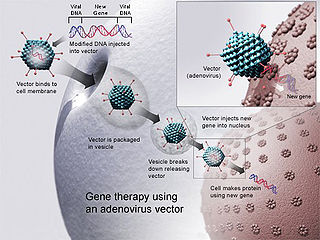Related Research Articles

Biotechnology is a multidisciplinary field that involves the integration of natural sciences and engineering sciences in order to achieve the application of organisms and parts thereof for products and services.

A genetically modified organism (GMO) is any organism whose genetic material has been altered using genetic engineering techniques. The exact definition of a genetically modified organism and what constitutes genetic engineering varies, with the most common being an organism altered in a way that "does not occur naturally by mating and/or natural recombination". A wide variety of organisms have been genetically modified (GM), including animals, plants, and microorganisms.

Genetic engineering, also called genetic modification or genetic manipulation, is the modification and manipulation of an organism's genes using technology. It is a set of technologies used to change the genetic makeup of cells, including the transfer of genes within and across species boundaries to produce improved or novel organisms.

Gene therapy is a medical technology that aims to produce a therapeutic effect through the manipulation of gene expression or through altering the biological properties of living cells.

Genetically modified foods, also known as genetically engineered foods, or bioengineered foods are foods produced from organisms that have had changes introduced into their DNA using various methods of genetic engineering. Genetic engineering techniques allow for the introduction of new traits as well as greater control over traits when compared to previous methods, such as selective breeding and mutation breeding.
The term modifications in genetics refers to both naturally occurring and engineered changes in DNA. Incidental, or natural mutations occur through errors during replication and repair, either spontaneously or due to environmental stressors. Intentional modifications are done in a laboratory for various purposes, developing hardier seeds and plants, and increasingly to treat human disease. The use of gene editing technology remains controversial.

Human genetic enhancement or human genetic engineering refers to human enhancement by means of a genetic modification. This could be done in order to cure diseases, prevent the possibility of getting a particular disease, to improve athlete performance in sporting events, or to change physical appearance, metabolism, and even improve physical capabilities and mental faculties such as memory and intelligence. These genetic enhancements may or may not be done in such a way that the change is heritable.

A designer baby is a baby whose genetic makeup has been selected or altered, often to exclude a particular gene or to remove genes associated with disease. This process usually involves analysing a wide range of human embryos to identify genes associated with particular diseases and characteristics, and selecting embryos that have the desired genetic makeup; a process known as preimplantation genetic diagnosis. Screening for single genes is commonly practiced, and polygenic screening is offered by a few companies. Other methods by which a baby's genetic information can be altered involve directly editing the genome before birth, which is not routinely performed and only one instance of this is known to have occurred as of 2019, where Chinese twins Lulu and Nana were edited as embryos, causing widespread criticism.
A transgene is a gene that has been transferred naturally, or by any of a number of genetic engineering techniques, from one organism to another. The introduction of a transgene, in a process known as transgenesis, has the potential to change the phenotype of an organism. Transgene describes a segment of DNA containing a gene sequence that has been isolated from one organism and is introduced into a different organism. This non-native segment of DNA may either retain the ability to produce RNA or protein in the transgenic organism or alter the normal function of the transgenic organism's genetic code. In general, the DNA is incorporated into the organism's germ line. For example, in higher vertebrates this can be accomplished by injecting the foreign DNA into the nucleus of a fertilized ovum. This technique is routinely used to introduce human disease genes or other genes of interest into strains of laboratory mice to study the function or pathology involved with that particular gene.
The Center for Genetics and Society (CGS) is a non-profit information and public affairs organization based in Berkeley, California, United States. It encourages the responsible use and regulation of new human genetic and reproductive technologies. CGS provides analysis and educational materials and organizes conferences, workshops, and briefings. This organization tends to particularly criticize proposals concerning reproductive human cloning and germline genetic modification—both uses of technology colloquially considered 'socially irresponsible.'
This page provides an alphabetical list of articles and other pages about biotechnology.

Ralph Lawrence Brinster is an American geneticist, National Medal of Science laureate, and Richard King Mellon Professor of Reproductive Physiology at the School of Veterinary Medicine, University of Pennsylvania.

A genetically modified mouse, genetically engineered mouse model (GEMM) or transgenic mouse is a mouse that has had its genome altered through the use of genetic engineering techniques. Genetically modified mice are commonly used for research or as animal models of human diseases and are also used for research on genes. Together with patient-derived xenografts (PDXs), GEMMs are the most common in vivo models in cancer research. Both approaches are considered complementary and may be used to recapitulate different aspects of disease. GEMMs are also of great interest for drug development, as they facilitate target validation and the study of response, resistance, toxicity and pharmacodynamics.

Plant genetics is the study of genes, genetic variation, and heredity specifically in plants. It is generally considered a field of biology and botany, but intersects frequently with many other life sciences and is strongly linked with the study of information systems. Plant genetics is similar in many ways to animal genetics but differs in a few key areas.

Genetically modified animals are animals that have been genetically modified for a variety of purposes including producing drugs, enhancing yields, increasing resistance to disease, etc. The vast majority of genetically modified animals are at the research stage while the number close to entering the market remains small.

Genetically modified fish are organisms from the taxonomic clade which includes the classes Agnatha, Chondrichthyes and Osteichthyes whose genetic material (DNA) has been altered using genetic engineering techniques. In most cases, the aim is to introduce a new trait to the fish which does not occur naturally in the species, i.e. transgenesis.

A genetically modified virus is a virus that has been altered or generated using biotechnology methods, and remains capable of infection. Genetic modification involves the directed insertion, deletion, artificial synthesis or change of nucleotide bases in viral genomes. Genetically modified viruses are mostly generated by the insertion of foreign genes intro viral genomes for the purposes of biomedical, agricultural, bio-control, or technological objectives. The terms genetically modified virus and genetically engineered virus are used synonymously.
Human germline engineering (HGE) is the process by which the genome of an individual is modified in such a way that the change is heritable. This is achieved by altering the genes of the germ cells, which mature into eggs and sperm. For safety, ethical, and social reasons, the scientific community and the public have concluded that germline editing for reproduction is inappropriate. HGE is prohibited by law in more than 70 countries and by a binding international treaty of the Council of Europe.
Horizontal Environmental Genetic Alteration Agents (HEGAAs) are any artificially developed agents that are engineered to edit the genome of eukaryotic species they infect when intentionally dispersed into the environment (outside of contained facilities such as laboratories or hospitals).

CRISPR gene editing (CRISPR, pronounced, refers to a clustered regularly interspaced short palindromic repeats") is a genetic engineering technique in molecular biology by which the genomes of living organisms may be modified. It is based on a simplified version of the bacterial CRISPR-Cas9 antiviral defense system. By delivering the Cas9 nuclease complexed with a synthetic guide RNA (gRNA) into a cell, the cell's genome can be cut at a desired location, allowing existing genes to be removed or new ones added in vivo.
References
- ↑ "Animals From Genetically Modified Sperm". Archived from the original on 2012-07-23. Retrieved 2009-11-26.
- ↑ Genetically modified sperm in fish
- ↑ Manzini, S.; Vargiolu, A.; Stehle, I.; Bacci, M.; Cerrito, M.; Giovannoni, R.; Zannoni, A.; Bianco, M.; Forni, M.; Donini, P.; Papa, M.; Lipps, H. J.; Lavitrano, M. (2006). "Genetically modified pigs produced with a nonviral episomal vector". Proceedings of the National Academy of Sciences of the United States of America. 103 (47): 17672–17677. Bibcode:2006PNAS..10317672M. doi: 10.1073/pnas.0604938103 . PMC 1635978 . PMID 17101993.
- ↑ Wang, H. J.; Lin, A. X.; Zhang, Z. C.; Chen, Y. F. (2001). "Expression of porcine growth hormone gene in transgenic rabbits as reported by green fluorescent protein". Animal Biotechnology. 12 (2): 101–110. doi:10.1081/ABIO-100108336. PMID 11808625. S2CID 23132238.
- ↑ Scientists 'five years away' from creating human sperm and eggs in a laboratory
- ↑ "Human genes placed in pigs". The Cincinnati Post. 2002-10-22. Archived from the original on 2012-11-03. Retrieved 2010-02-08.
- ↑ "The Basic Science". Center for Genetics and Society. Archived from the original on 2015-04-17. Retrieved 2015-04-17.
- ↑ "Inheritable Genetic Modification". Center for Genetics and Society. Archived from the original on 17 April 2015. Retrieved 11 April 2015.
- ↑ Hanna, Kathi. "Germline Gene Transfer". National Human Genome Research Institute. National Institutes of Health. Retrieved 10 April 2015.
- ↑ "Regulations of Genetically Engineered Animals". U.S. Food and Drug Administration. Food and Drug Administration. Retrieved 10 April 2015.
- ↑ Rasko, John; O'Sullivan, Gabrielle; Ankeny, Rachel (2006). The Ethics of Inheritable Genetic Modification - A Dividing Line?. Cambridge University Press. doi:10.1017/CBO9780511584275.003.
- ↑ "Sperm bank sued under product liability law". New Scientist . 2009-04-08. Retrieved 2010-02-08.
- ↑ Knapton, Sarah (June 2014). "Robert Winston: my research could open door to 'risky' eugenics". The Telegraph. Retrieved 11 April 2015.